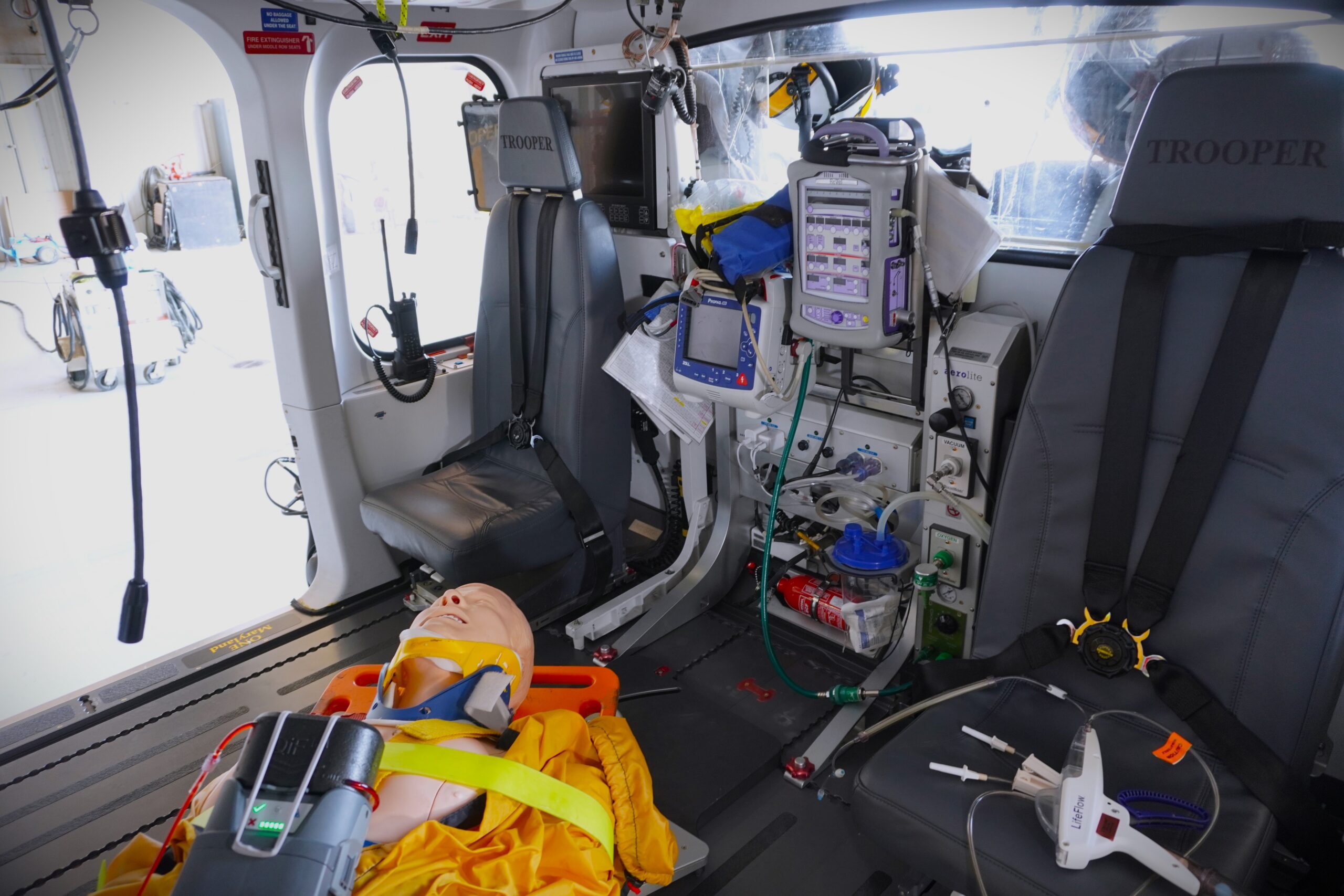As MSP expands ability to treat patients with ‘blood on board’ choppers, officials stress need for improved trauma care funding

Trauma physicians and emergency responders gathered at the Martin State Airport in Middle River this week to highlight a new partnership that will allow emergency blood transfusions — on board Maryland State Police “Trooper” helicopters en route to trauma hospitals.
The so-called “Blood on Board” project announced Monday is just one leg of Maryland’s trauma care network, an emergency health response that helps get immediate care to those facing life-threatening injuries or other time-sensitive critical conditions.
“You’re racing against time to reach a patient who’s in dire need of life-saving intervention,” Sgt. Joshua Heins, a flight paramedic with the Maryland State Police, said at the Monday press conference discussing the new development. Maryland is the first state to offer the lifesaving Blood on Board initiative statewide, officials said. So far, blood has been transfused in the field to 21 patients who were critically injured in motor vehicle crashes, machinery accidents and shootings.
Some of the patients likely would have died had they not received in-flight transfusions, officials said.
“We see so many critically injured patients with significant life-threatening blood loss, and providing basic IV fluids isn’t sufficient at times to sustain the life,” Heins said.
In-flight emergency blood transfusions will not only help replenish the blood volume that someone has lost while in transit for further care, they could also provide “the opportunity to assist with clotting and transport oxygen to the tissues and cells.”
The press conference was a celebration of a new opportunity to save lives in the field, but just days before, state and county officials were warning that the state’s trauma care system is facing future financial woes and that the General Assembly may need to get creative in order to fund the emergency care in years to come.
The issue was raised last week at the Maryland Association of Counties summer conference.
In a bipartisan effort to draw attention to the funding needs of the trauma network, state Sen. J.B. Jennings (R-Baltimore and Harford) and Baltimore County Executive John Olszewski Jr. (D) held a panel on the future of trauma care in Maryland.
They were joined by Dr. Thomas Scalea, physician-in-chief for the University of Maryland Medical System’s R Adams Cowley Shock Trauma Center. He has more than 25 years of experience in shock trauma care and explained that trauma care goes well beyond the immediate methods to stabilize someone in critical condition.
“It (trauma care) has a prevention strategy, it has treatment strategy, it has a rehabilitation strategy,” Scalea said. “And if you are a trauma patient, what you want is to go through injury, to care, to rehab, to reintegration into society and as effectively as possible. And it is very, very clear that organized trauma care save lives.”
He argued that the trauma system should be well funded now, otherwise the costs to rebuild a failing system would be “much greater.”
At the panel, Jennings identified himself as “a guy who hates taxes,” but for him, fully funding trauma care is crucial to protecting lives across the state and that “everything’s on the table” when it comes to potential policy solutions that could be considered to increase funding for the system.
In a later interview with Maryland Matters, he elaborated on that statement.
“When I said that comment, I’m saying ‘Look, we’ve got to figure out how to fund this and add more money to their formula,'” Jennings said. “Whether it’s ‘cut from another program,’ whether it’s ‘seek federal funds,’ whether it’s ‘seek additional state funds,’ whether it’s ‘change other formulas’ — I don’t know. But I am willing to sit down and discuss to come up with something to make it work.”
Meanwhile, Gov. Wes Moore (D) warned state and local leaders at the conference that the Maryland is facing a challenging upcoming fiscal year, and that he may have to make some difficult decisions when it comes to the state budget.
During the 2023 legislative session, the General Assembly passed legislation that created the Commission to Study Trauma Center Funding in Maryland, in order to evaluate the adequacy of current state funding to support trauma centers.
Sen. Mary Beth Carozza (R-Lower Shore), who helped push the bill forward, she said that the legislature created the Maryland Trauma Physician Services Fund in 2003 to support the state’s trauma system, but there has not been a comprehensive review of the fund in the 20 years since.
“We know that the fund was not as effective as it was intended to be,” she said back in March.
The Maryland Trauma Physician Services Fund is maintained through a $5 surcharge on car registration renewals. It covers a host of costs involved in keeping the trauma system going: “medical care provided by trauma physicians at Maryland’s designated trauma centers for uncompensated care, Medicaid-enrolled patients, trauma related on-call and standby expenses, and trauma equipment grants.”
Maryland currently has 10 facilities that are designated as trauma care centers across the state.
According to a 2022 Maryland Health Care Commission report to the General Assembly, the car registration fee brought in $12,227,047 in 2022, compared to more than $12.5 million the year before and just under $11.8 million in 2020. A few other grants brought in additional funds in 2022, and the fund had a reserve of about $6.7 million at the end of 2022.
While the report estimates that the current formula may hold the trauma system for a couple more years, the Maryland Health Care Commission suggests that the $5 registration fee could be raised to $6 to better support the network, as the registration fee has not been raised since the early 2000s.
But trauma care is something that is often seen as something people do not think about until it fails. That’s the sentiment that was shared at the Monday press conference in Middle River.
Heins, the sergeant with the Maryland State Police, described the myriad medical situations that could benefit from the new “Blood on Board” program.
“For the aviation command, this patient can be one that’s been shot, stabbed, were involved in a motor vehicle crash,” Heins said Monday. “Or, it could be a mother suffering from a postpartum hemorrhage, patient with a ruptured aneurysm or someone with serious gastrointestinal bleeding…our aviation command now has the ability to vastly improve a patient’s chances of recovery.”




 Creative Commons Attribution
Creative Commons Attribution